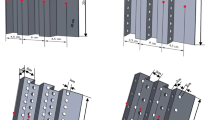Abstract.
The heat transfer dissipation from a horizontal rectangular fin embedded with square perforations of two orientations under natural convection is numerically investigated. The parameters considered in this investigation are the geometrical dimensions and the orientations of the perforation. A comparison between heat dissipation of the fin with variable orientations of the perforations is presented. It is found that the heat dissipation enhancement from a fin with square perforation parallel to the fin base was more than that of fin with inclined square perforation. The problem of this study was numerically solved using the variational approach finite element technique.









Similar content being viewed by others
References
Incropera F; Dewitt D (1996) Fundamentals of Heat and Mass Transfer (4th Edn), Wiley, New York
Shah RK (1981) Classification of heat exchangers. In: Kakac S, Bergles A, Mayinger F (eds) Heat exchangers, thermal-hydraulic fundamentals and design hemisphere publishing, New York
Aziz A; Lunadini V (1995) Multidimensional steady conduction in convicting, radiating, and convicting-radiating fins and fin assemblies. Heat Transfer Eng 16(3): 32–64
Prasad PVSSS; Gupta AVSSKS (1998) Note on the performance of an optimal straight rectangular fin with a semicircular cut at the tip. Heat Transfer Eng 14:1
Raithby GD; Holands KGT (1984) Natural convection. In: Rohsenow W, Hartnett J, Ganic E (eds) Handbook of heat transfer applications, 2nd edn, McGraw-Hill Book company, New York
Bergls AE (1984) Technique to augment heat transfer. In: Rohsenow WM, Hartnett JP, Ganic EN (eds) Handbook of heat transfer fundamentals (2nd Edn), McGraw-Hill Book company, New York
Mullisen R; Loehrke R (1986) A study of flow mechanisms responsible for heat transfer enhancement in interrupted-plate heat exchangers. J Heat Transfer (Transactions of the ASME) 108(3) 377–385
Kutscher C (1994) Heat exchange effectiveness and pressure drop for airflow through perforated plates with and without crosswind, J Heat transfer 116(2) 391–399
Sparrow E; Oritz M (1982) Heat transfer coefficient for the upstream face of a perforated plate positioned normal to an oncoming flow. Int J Heat Mass Transfer 25(1): 127–135
Rao SS (1989) The finite element method in engineering. Second Edition, Elmsford, New York: Pergamon
Al-Essa AH (2000) Enhancement of thermal performance of fins subjected to natural convection through body perforation. Ph.D. thesis, Department of Mechanical Engineering, University of Baghdad, Iraq and Jordan University of Science and Technology
Author information
Authors and Affiliations
Corresponding author
Rights and permissions
About this article
Cite this article
Al-Essa, A.H., Al-Hussien, F.M.S. The effect of orientation of square perforations on the heat transfer enhancement from a fin subjected to natural convection. Heat and Mass Transfer 40, 509–515 (2004). https://doi.org/10.1007/s00231-003-0450-z
Received:
Published:
Issue Date:
DOI: https://doi.org/10.1007/s00231-003-0450-z



